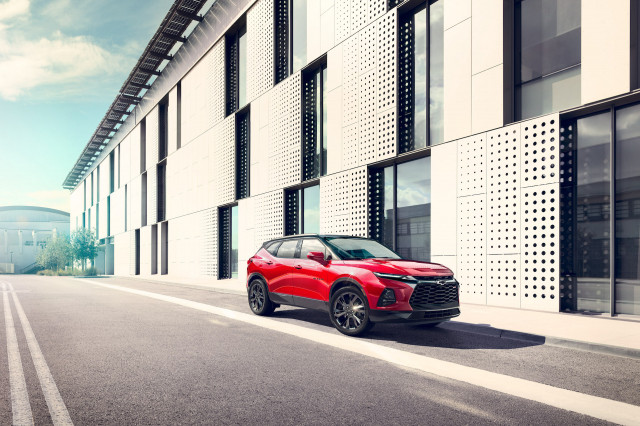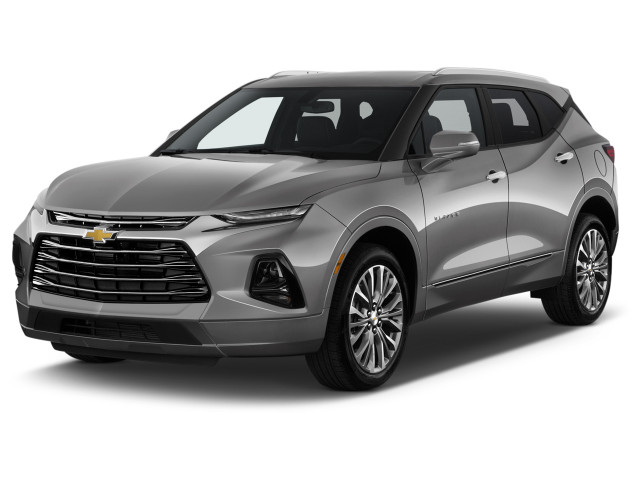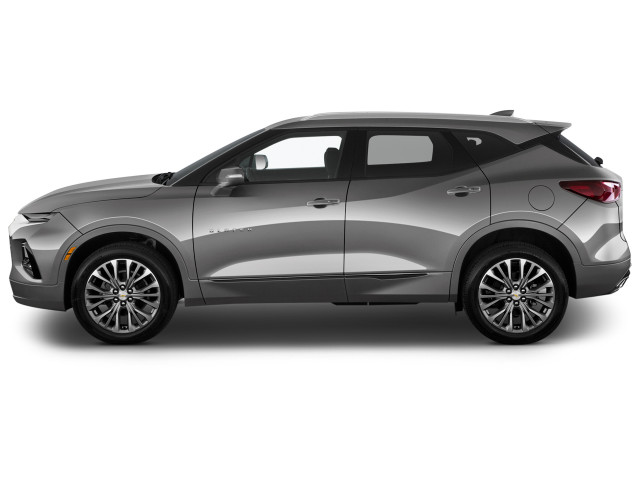LIKES
- Sharp RS trim
- Impressive handling
- Strong turbo-4
- Larger touchscreen
- Standard safety tech
DISLIKES
- Equinox’s about the same size
- Seats aren’t comfortable
- Top trims get expensive
- Middling gas mileage
BUYING TIP
- The base turbo-4 gets the job done, but beware the siren call of the Blazer’s throaty V-6.
The 2023 Chevrolet Blazer gives Chevy a sportier five-seat crossover option over the Equinox.
What kind of car is the 2023 Chevy Blazer? What does it compare to?
Setting aside the rough-and-tumble trucky Blazer of the 1990s, the Blazer resurrected in 2019 sports a sharp design in an anodyne class populated by the Ford Edge, GMC Acadia, Honda Passport, and Hyundai Santa Fe.
Is the 2023 Chevy Blazer a good car?
Sold in 2LT, 3LT, RS, and Premier trim, the 2023 Blazer is a solid mid-size SUV with good infotainment and better steering and handling than its competitors. It warrants a TCC Rating of 6.5 out of 10.
What’s new for the 2023 Chevy Blazer?
The Blazer wears new ends with new light signatures, while the interior sports a larger 10.0-inch touchscreen as standard equipment. Chevy expanded the availability of certain features, but expect big changes to the mid-size crossover next year, when Chevy debuts a battery electric Blazer.
The Blazer’s standard 228-hp turbo-4 with front-wheel drive offers pert acceleration, but the 9-speed automatic can be indecisive at mid-throttle. It rides firmer and handles better than the usual crossover, though. For the most blazing Blazer, check out the RS and its sonorous 308-hp V-6. While all-wheel drive is available on all Blazers, the RS has a twin-clutch system that vectors torque to the rear wheel with the most grip for more spirited handling. It’ll cost you, though.
The Blazer seats five with more room and better quality than the slightly smaller Chevy Equinox, but the seats need better padding. The front seats have narrow, short bottom cushions that crimp larger frames, and the rear seats aren’t much better. Fortunately, the sliding rear seats have plenty of leg room, and can be folded down for more than 64 cubic feet of cargo room.
Crash-test scores have been good, with headlights dimming Top Safety Pick status from the IIHS. New LED headlights could change that this year. Every Blazer comes well equipped with driver-assist features such as automatic emergency braking and active lane control, while adaptive cruise control is now available across the lineup this year.
How much does the 2023 Chevy Blazer cost?
Pricing had not been announced as of publication time, but expect at least a $1,000 increase over the $35,000 Blazer 2LT in 2022. Standard features include the turbo-4, 18-inch wheels, power driver seat, and 10.0-inch touchscreen with Apple CarPlay and Android Auto. Expect to pay in the mid-$40,000s for a Blazer RS and its more sophisticated AWD system or the Premier with its V-6, Bose audio, and bigger wheels.
Where is the 2023 Chevy Blazer made?
In Spring Hill, Tennessee.
Styling
New ends and a larger command center distinguish the Blazer.
Is the Chevy Blazer a good-looking car?
It’s the flashiest Chevy this side of the Corvette and Camar-who, but it’s a steep drop off from there. Still, the new ends on the 2023 Blazer stand out, even if they’re more flash than function. It’s a 7, with a point each for the fit bod and the sport-jacket-like interior.
The refreshed front end wears slimmer LED running lights over the bowtie crossbar, and a wider honeycomb grille gives it a lower, broader face that’s matched by wide haunches on the sides. The LED headlights also get thinner and narrower, which is mirrored in back with thinner taillights. In profile, a blacked-out roof meets the rising window line at the integrated roof spoiler to give it a fluid vibe.
Performance
The sporty Blazer cuts a sharper edge than other crossover SUVs.
The Blazer impresses with its tight ride and crisp steering, earning it a point, and its choice of peppy powertrains earn it another point to a 7. The V-6 standard on the RS trim beckons with its purr and its power, but the turbo-4 wins the value game.
How fast is the Chevy Blazer?
That 228-hp 2.0-liter turbo-4 churns out 258 lb-ft of torque as early as 1,500 rpm, giving it some quickness that belies its 4,000-lb curb weight. It builds power quickly, but the 9-speed automatic can bounce around if you’re not firm with your commitment. Lay in hard and it’ll reach 60 mph in less than eight seconds with standard front-wheel drive. The RS model with the standard 3.6-liter V-6 flirts with six seconds on its 0-60 mph sprint, and its raspy exhaust adds some sportiness suggested by the Blazer’s crossfit dad bod. Available on 3LT and Premier trims as well, the V-6 makes 308 hp and 270 lb-ft. Its acceleration commands respect in this class, but the roughly $8,000 upcharge might make eyes wander to other showrooms.
Front-wheel drive comes standard across the board, while two all-wheel-drive systems distinguish the RS from the rest of the pack. The turbo-4 Blazer uses a basic and reactive all-wheel-drive option that couples the rear axle once the system detects front wheel slip. The V-6 RS utilizes a twin-clutch rear differential that apportions torque between the rear wheels to increase grip and improve handling.
Drivers can activate a sport mode with the flip of a console switch on the Blazer RS, commanding the 9-speed automatic to hold low gears and dig deeper into the power band, as well as add heft to the steering.
The steering impresses on any Blazer, however, with more precision than duller crossovers that model steering off a Sea Ray. Wheel sizes range from 18 to 21 inches, and the bigger you go, the more you’ll feel our infrastructure dollars failing us. That doesn’t mean the smaller wheels on the LT provide a superior ride; RS and Premier versions flex stiffer struts and shocks and overall better handling and ride quality.
Comfort & Quality
These seats should be stuffed instead of starved.
A mid-size crossover SUV, the Blazer seats five and fits plenty of gear to earn a point, but it loses possible points for thin, narrow seats front and back. It’s a 6.
The base Blazer sports bucket seats with an 8-way power driver seat and cloth upholstery but it's too cramped and lacks the padding to be comfy. The short seat bottoms with thin padding don’t accommodate larger frames, and it might make some owners think twice about a road trip. RS and Premier Blazers can be had with perforated leather, but a heated steering wheel or cooled seats costs extra even on the top trim.
The 60/40-split second row also slides back to expand or contract passenger and cargo space, depending on your needs. Head room and leg room is excellent because of it, with nearly 40 inches of leg room, but like the front seats the rear bench could benefit from more padding. Still, it’s a squeeze to fit a third person in the middle.
With its black-on-black trim and fake chrome bands, the Blazer’s interior materials and price more closely resemble a GMC Denali without the wood trim than the slightly smaller and less expensive Chevy Equinox. True to name, the Blazer wears it better inside and has better sound damping and active noise cancellation.
Safety
The Blazer’s strong safety record dims on headlights.
How safe is the Chevy Blazer?
The NHTSA rates it at five stars overall, and the IIHS rates it “Good” on all six crash tests. But subpar ratings on its headlights kept it from Top Safety Pick status. Standard automatic emergency braking earns it a point, as does the NHTSA’s rating for a 7 here, despite a four-star rating in rollover crash tests.
In addition to automatic emergency braking, active lane control, and automatic high-beam headlights, as well as blind-spot monitors and rear parking sensors. Options include adaptive cruise control available on all trims, a surround-view camera system and a rear camera mirror that is helpful for seeing beyond the Blazer’s thick rear pillars and narrow rear view.
Features
The refreshed Blazer arrives with a larger 10.0-inch touchscreen on every model.
The Blazer earns an 8, with points for its standard equipment, larger infotainment touchscreen, and for value that erodes on the higher trims.
Which Chevy Blazer should I buy?
Offered in 2LT, 3LT, RS, and Premier trims, the base Blazer 2LT has become a sweeter deal with more driver-assist features and the larger 10.0-inch touchscreen with Apple CarPlay and Android Auto. Powered by the turbo-4, the 2LT has 18-inch wheels, keyless start, and a power driver seat. Chevy has democratized the options list, too, with features such as wireless smartphone charging, adaptive cruise control, and the V-6 available on the 2LT.
How much is a fully loaded Chevrolet Blazer?
Pricing hasn’t been announced for the 2023 model, but expect it to cost about $1,000 more than last year’s $42,000 Blazer RS or Blazer Premier. The RS comes with a hands-free liftgate, remote start, navigation, wireless smartphone charging, a sunroof, and 21-inch wheels. The posh Premier has Bose audio.
The Blazer’s infotainment interface and its larger 10.0-inch touchscreen is intuitive and easy to operate, but be wary of subscription-based wifi and navigation that will increase the cost of ownership. Smartphones can do it just as well.
Fuel Economy
The Blazer gets average fuel economy.
Is the Chevrolet Blazer good on gas?
With an EPA rating of 22 mpg city, 29 highway, 25 combined, the turbo-4 Blazer with front-wheel drive is average for mid-size crossovers. All-wheel drive drops the turbo-4 to 22/27/24 mpg. It’s a 4.
The V-6 burns gas at a rate of 19/27/22 mpg or 19/26/21 mpg with AWD.











0 comments:
Post a Comment